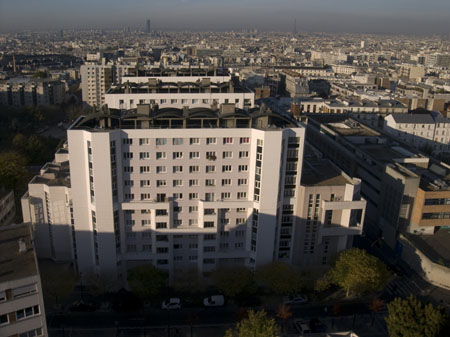The Contexts
Focusing on different contexts
Chosen for their distinctive nature, each location has its own local history, which is considered below.
Newham is one of the poorest and most diverse boroughs of London.
Casal da Boba is a neighbourhood located in Amadora, a city in the suburb of Lisbon. It is home to people whose families came from the Cap Verde Islands. They used to live in slums, but apartment flats with gas and electricity have now replaced the former improvised houses.
Paris 20th is one of the poorest districts within the walls of the city, near the ‘back-door’ of Paris, a working class area where successive groups of immigrants have settled. Many social housing estates were built in the 1970s.
© Collectif Tribudom 2008
Preparing and integrating the social history elements of the project
In each workshop location, a social/local history ‘workshop pack’ was prepared, concisely addressing:
- Britain/Portugal/France in the history of Western European expansion (explorations, invasions, emigrations, colonisations, economic exploitations), and consequent national and global changes over centuries;
- London/Lisbon/Paris as cities in global history, and the impact on their local histories (the history of ‘other’ people's presences and contributions from abroad in their economic and social development);
- London/ Lisbon/Paris/: 20th and 21st century immigrations and settlements;
- Newham/Casal da Boba/Paris 20 arrondisssement: the very local social history of each city workshop, 20th and 21st century.
"I was asked MY ideas and opinions so my film would be based on my abilities"
Taking into account the specificity of each workshop location and adapting the project accordingly
Each project location chose its own ways of delivering the historical element of BELONGING.
In London it was delivered during the fist day of the workshop, by the workshop tutors. In Paris, the team took the young participants to the new museum ‘La Cité Nationale de l’Histoire de l’Immigration’ - a museum telling the (hi)story of immigration in France through a creative multi-media exhibition. This was followed by a local history walk in the 20 arrondissement of Paris, delivered by a local historian. In Lisbon, the local history element was delivered as a slide show on day one of the workshop.
Unleashing voices of urban youth creatively, through video
A major objective of BELONGING was to create the right setting to unleash voices of urban youth engaging with the question of ‘who belongs?’ and related social issues of immigration, xenophobia, and identity in the new Europe of the 21st century.
"I’d like to say that I enjoyed being with all the people and I loved the workshop.
To tell the truth I didn’t want it to end."
BELONGING endeavoured to use art as a refresher of cultural discourse – through the production of image-rich video essays. The video workshops brief was to deliver the creation and production of bold, exciting and varied video essays or stories – opening up the subject of how the young participants feel they belong. To this end, workshop facilitators had to ensure that they would find ways of infusing the workshops with the challenge of being (artistically) imaginative.
As a starting point for discussion, it was agreed that the workshops would focus on the lived experience of ‘belonging’ in new 21st century Europe – either the experience of the young people, or of someone they knew (friend, family).
Language and music issues
Workshop participants were also urged to think of using ‘language’ that translates and which can be comprehensible across the language/country sites of the project – avoiding too much talk and, as much as possible, expressing narrative through use of images.
Similarly, young people were encouraged to use sounds and create music themselves (including collaboratively).

